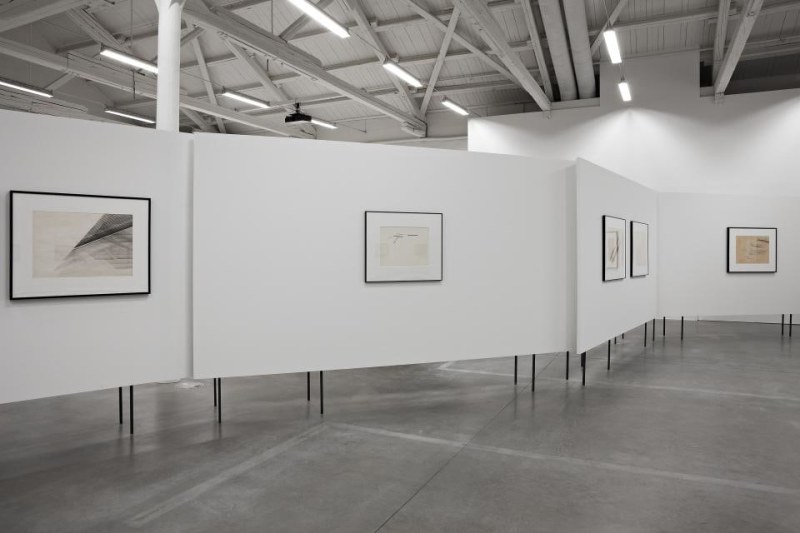
Housed in the airy precincts of a light-filled gallery, " Nasreen Mohamedi: Notes-Reflections on Indian Modernism" was an invitation to look and linger. Curated by Bangalore-based Suman Gopinath and Antwerp, Belgium-anchored Grant Watson, this retrospective (significantly expanded from the version seen at Office for Contemporary Art Norway in Oslo earlier in 2009) followed Mohamedi's aesthetic journey from the early 1960s to the late ' 80s (she died of Parkinson's disease in 1990). Here, monochromatic pen, ink, and pencil drawings and black-and-white photographs were accompanied by glass vitrines containing personal possessions-her favorite geometrically embroidered cushion. Offering cleverly chosen samples of Mohamedi's oeuvre, "Notes" accommodated silvery gray, semiabstract collages from the '60s, delicate penciled grids from the '70s, and fragile ink drawings of lines, triangles, and rectangles ascribed to the '80s-though since Mohamedi neither named nor dated her output, the periodization of her pieces can be speculative.
One of India's few well-known abstractionists, Mohamedi was born in Karachi, Pakistan, in 1937, grew up in Mumbai studied in Europe, and finally settled in Vadodara, India, in 1972. In contrast with the socially rooted figure at io n that dominated Vadodara's art scene in the '80s- typified by Bhupen Khakhar's iridescent Pop paintings of gay men in obviously Indian settings- her monochrome musings eschew color and representation and, in tune with Zen Buddhism and Sufism (Mohamedi was fascinated by the spare fluidity of Japanese and Arabic calligraphy, as magazine cuttings showcased in the vitrines testified), their mesmeric quality relies on simple forms. In an untitled, undated, pen-and-pencil work, faint straight lines crisscross with tiny, thicker diagonal ones on cream paper. The taut composition appears to pulsate with life. Little leaves seem to swirl in a storm or minute figures to writhe in wire meshes, but looking again, we realize our mistake: Attention reveals only precise black and silvery markings.
Despite giving the viewer the feeling of peeking into secret spaces complete with diary entries and photographs (none of which Mohamedi made for public perusal) - "Notes" was sensitively conceived, not intrusive. Perhaps the systematicity of the artist's vision accounts for this; it is as if her experience of an outer reality were prearranged according to an inner impulse. Since both drawings and personal possessions echo one another in their austerity, there is little to separate life from art. A blackand-white photograph, thought to be from the '70s, shows a tiled floor leading to wide steps that cast dark shadows. An extreme close-up of the structure, the snapshot seems to comprise floating bands of light and shade. It is similar to another untitled pen, pencil, and ink drawing from the same period, in which an array of inky black rectangles suspended on a blank page resembles a blueprint for a many-tiered building.
Architectural motifs like these permeate Mohamedi's work. And with its clean lines, muted color scheme, and square tiles, the gallery itself seemed a 3-D version of one of her pictures. Indeed, the affinity was more than superficial. Developed in the '60s, Milton Keynes, with its boxy buildings and neatly gridded streets, is one of Brita in's "New Towns" created to alleviate urban housing demand. In as much as its main gallery's geometric architecture is a product of unfulfilled utopian fantasies, it mirrors Mohamedi's own doomed quest for order. In one Untitled pen -and-pencil drawing, gray and black triangles are sketched one on top of the other, hovering over finely ruled lines. Some darker, others lighter, the triangles overlap, seeming to move and merge, twist and turn in trance-inducing dances. The image might pass for something manufactured with a compass set in geometry class, but mathematical certainties are far away: The longer we stare at the work's pristine patterns, the more precarious our sense of balance becomes. Was Mohamedi's art her last bid for control before she succumbed to Parkinson's disease? Despite the seeming straightforwardness of her black-and-white universe, control is never as far removed from chaos as it might at first appear.
-Zehra Jumabhoy